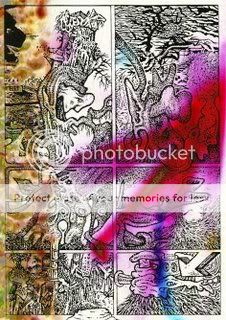Over at Comicscomics, T. Hodler feels strongly that talking to me about the impact of literature on comics is boring, and yet he can’t seem to help himself. I must admit I find the apologizing rather silly — no one’s holding a gun to your head, man. It would be fun to link this sort of pointless public agonizing to the more preposterous indulgences of literary fiction and its comics hangers on — but, to be fair, it probably has more to do with the odd compulsions of the Internet and the bloggers tendency to just say whatever comes into ones head (a tendency to which I’m certainly not immune myself).
Anyway, In yet another post, Hodler references a New York Review of Books essay which grinds out the usual elitist sneering at pop culture
Welcome to New Dork! We have been airpopped and multimediated unto inanity and pastiche. Philip K. Dick and Stan Lee get made into Hollywood movies. Alienation and sexual terror have their own sitcoms, fashion statements, and marketing niches. The middle finger and the Bronx cheer are required courses in cultural studies. Boomers have made sure that their every febrile enthusiasm since Pampers will last longer than radioactive waste, on digital cable or DVD. Gen-Xers are just as solipsistic; anything that ever mattered to them must have been profound, even, say, Debbie Harry of the pop group Blondie talking to MTV while a sirocco blows in one of her ears and out the other and neurons die like flies. BITE MY CRANK, SUPER GOAT MAN!
As you can see, it’s actually pretty well done, and there’s even a certain extent to which I agree, though for slightly different reasons. For me, it’s not that the nostalgia for Blondie makes the band overly significant — I quite like Blondie, as it happens, and Debbie Harry back in the day was certainly more of an artist than some pompous (albeit fairly clever) culture flak writing for the NYRB. Rather, the irritating bit is that McSweeny’s and its ilk tend to want to turn pop culture into nostalgia. Michael Chabon isn’t actually thinking about or even really celebrating Marvel Comics — he’s validating them by his regard. This is what irritates me about many art comics as well — the idea that a literary sensibility makes the medium worthwhile, and that the way to salvage the super-hero past is with layers of oleaginous nostalgia.
Anyway, Hodler is, I think, alluding to me as the contrary voice who dislikes comics because they’re too literary. I actually wrote a bit on this topic for the Journal in my contribution to the best of issue in February. So I thought I’d trot that out again: it’s reprinted below
BEST OF 2006
High-brow comics and high-brow literature have grown closer and closer in recent years. Comics creators like Art Spiegelman and Charles Burns have been commissioned to do covers by a major literary publisher; the NYT has published serials by Chris Ware, Jaime Hernandez, and others.
From an industry standpoint, it’s nice to see comics creators getting access to more high-profile venues. From an aesthetic perspective…well, contemporary literary fiction is a pretty unpromising model. Insular, fusty, pompous without real intellectual content, ironic without actual wit, it tends to equate quality with boredom, or (at best) with a kind of smug whimsy. By taking literary fiction as their model, art comics seem bent on exchanging joy, imagination, and bite for a one-way ticket to credibility.
Contemplating this transaction inevitably depresses me. So, as an antidote, I thought I’d use this “Best of” to talk about a few comics produced this year which show that “engaging with literature” doesn’t have to mean “ramming a pole up your ass.”
KKK (Klassic Komix Klub) by Johnny Ryan, self-published
As long as I’ve introduced the gratuitous butthole imagery, I might as well start with this. KKK is the latest slim, self-published, limited-edition collection of Ryan’s page-long satirical strips. This group is focused on literary classics — “Crime and Punishment,” “Animal Farm,” and so forth. Ryan does to these canonicl works of genius what we all probably wanted to do to them in middle-school —he turns them into elaborate dick-jokes, shit-jokes, and cunt-jokes. Of course, most middle-schoolers (or adults, for that matter) can’t match Ryan’s creativity. Some of the best ones are those in which Ryan defaces his predecessors in surrealism. The Kafka strip, featuring a roach whose dick is transformed into a taco and whose ass changes into 9/11, is a highlight, as is the Phillip K. Dick parody. But whatever Ryan’s target, it’s exhilarating to see western culture sneered at so thoroughly and effectively. In an ideal world, these would be distributed in English classes nationwide — as a culture, we need to be doing much more to teach our children to hate literature.
Moomin by Tove Jansson, Drawn and Quarterly
Jansson’s Moomin characters started out in the 1940s as a series of illustrated children’s books. At first, Jansson’s adaptation of the material to comics form seems pretty straightforward. Favorite characters — Moomintroll, Sniff, Snufkin, the Snork Maiden — are all there. The size and time demands of a daily strip mean that the artwork, which at its most striking looks a little like a combination of A.A. Milne and Paul Klee, is never shown to its best effect. Still, the drawings are charming and full of gorgeous detail (the decor of a luxury hotel is particularly gorgeous.) The hippo-like Moomins couldn’t be cuter, and the supporting character designs are just as delightful.
On closer inspection, though, it becomes clear that, whatever the superficial similarities, the comic Moomins are very different animals from their literary relatives. The books feature gentle, reflective stories shot through with mystery and (especially in the later novels) melancholy. The comic strips, on the other hand, are rollicking, madcap adventures — they’re smart, satiric, and laugh-out loud funny. Sniff, a character represented as a somewhat timid child in the books, here becomes an amoral, get-rich-quick schemer. The decidedly un-militant Moomintroll actually fights (and wins!) a duel. And, in the comics most bizarre sequence, Moominmamma hunts, slaughters, and cooks a sentient pig.
Part of this transformation is probably because the books were intended for children, while the comics are aimed at adults. But part of the change is probably Jansson’s reaction to the comic genre’s history of slapstick and broad humor. Her take on that tradition is every bit as unpredictable and surreal as Johnny Ryan’s (though a good deal less scatological). Moomintroll’s parents find their long-lost son then abandon him again almost instantly; fruit-tree seeds sprout a full crop of marauding poor relations; mummified Moomin ancestors come alive to lure ships to their doom. The sublime nuttiness of these strips is so perfect it’s hard to believe that Jansson only focused on comics for half a decade or so. I guess if you’re a great writer and a great artist, there’s a good chance that you can make the transition to great comic creator without too much struggle.
The Illustrated Jane Eyre by Dame Darcy, Viking
I reviewed this for TCJ a couple of issues ago, and I still think it’s a masterpiece. Darcy’s bizarre, twisted, doll-like figures, enormous mooning eyes, and overall gothic sensibility fit Charlotte Brontë like a black and flowing garment . Moreover, while Darcy clearly loves the book she doesn’t revere it, so she’s able to stay true to the novel without being stodgy. One of the best examples of this is the color plate showing the moment when Rochester proposes. It’s completely over-the-top, including a lightning-fork that just barely misses Jane and a ravishingly-designed moth that appears to be the size of a small biplane. The illustration isn’t literally accurate, but it does capture the ludicrous air of impending doom which hangs over the scene — and, indeed, over the whole book. For the Victorians, pulp and high art hadn’t quite parted company. They have now, as I’m sure Dame Darcy knows — even if, God bless her, she refuses to admit it.
The Tale of Genji by Yoshitaka Amano, DH Press
Darcy’s Jane Eyre reprints the entire text of the novel; Amano’s illustrated edition of The Tale of Genji only has a few pull quotes and some plot summaries. This puts the focus squarely on Amano’s artwork — which is fine by me. I wish everyone who praised Melinda Gebbie’s mediocre Art Nouveau pastiches in Lost Girls could see this book. It’s almost a how-to manual for the decadent artist. Striking off-center compositions? Check. Unbelievably detailed color fabrics? Check. Elegant ectomorphs entwined in languid passion? Check. The pictures are so rich in color and detail that looking at them is a little like being asphyxiated in an avalanche of buttercream. The book is a confection…but it’s a confection constructed with awe-inspiring skill, conviction, and invention. Amano does work for video-games, and he’s got the signature virtues of a thoroughly popular romantic artist. I’ve been obsessed with contemporary R&B recently, and The Tale of Genji reminds me of tracks like Cassie’s “Ditto” or Faith Evans’ “Tru Love,” in which frilly, intricate surfaces evoke and contrast with depths of bittersweet longing. Or if that all sounds too girly for you, let me try this: Amano is in every way a worthy heir to the 19th century Japanese print-makers he admires. He’s that good.
The Flaming Fire Illustrated Bible, edited by Patrick Hambrecht, and Kate Hambrecht, online
This ongoing online project has been around for a while, but I only discovered it this year — much to my delight. The Flaming Fire Illustrated Bible is devoted to illustrating every verse in the Bible. That’s right. Every. Single. Verse. That means upwards of 36,000 illustrations. To accomplish this quixotic task, the Flaming Fire site relies on, basically, everyone. The site is open to any artist who wants to contribute. All you do is register, select the verse you want to illustrate, upload your image, and you’re part of the solution.
The Internet is easy to overhype, and it certainly hasn’t produced the revolution in comics form that its most ardent advocates have prophesied. Still, the Web really does open up some new and intriguing possibilities. Chief among these is the possibility of collaboration on an enormous scale, as Wikipedia has demonstrated. The number of people participating in the Flaming Fire project is many, many fewer than the number who write for Wikipedia, and the site may well never reach its goal of a drawing for every verse. Still, with almost 3000 images, it is already, I believe, the largest illustrated Bible in the world.
Since the project is open to all, a fair percentage of the art is mediocre (one of the most active artists currently, Pumelo Nalso, does Photoshopped collages which make my stomach hurt.) And, alas, the mauve banner displaying the text of each verse is ugly, and detracts from the art. But, on the plus side, a surprising number of the illustrations are good. And the real joy of the project is that once you start poking around on the site, you never know what you’ll find. There are illustrations by fundamentalist believers, agnostics, atheists and ministers. There are drawings by well-known artists (Tony Millionaire, Danny Hellman, Lauren Weinstein) and by complete unknowns. I just logged onto the site and found a bizarre drawing in delicate colored pencil for Mark 10:15, in which God appears to be represented as a stern, big-cheeked, blue-skinned, gnome-like children’s balloon.
I’ve done some drawings for the site myself, so my main motive in mentioning it here is shameless self-promotion. But, secondarily, I think it’s worthwhile to draw attention to any inclusive, community-friendly art project which is not a bland, focus-grouped mess. Because the Bible is such a central text in our culture, and because the goals here are clear without being restrictive, there’s room for lots of different artists to fit their individual talents and ideas into a common framework. As a result, this is easily the comics-related endeavor that most inspired and excited me this year.



